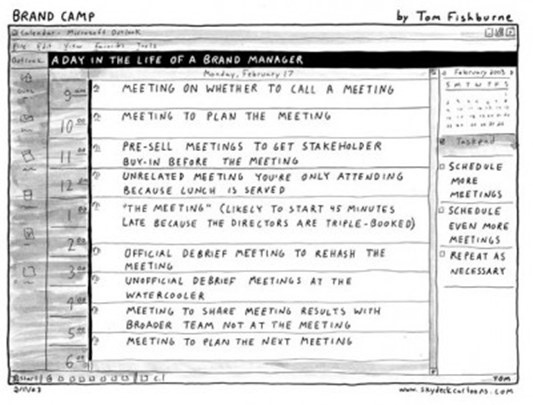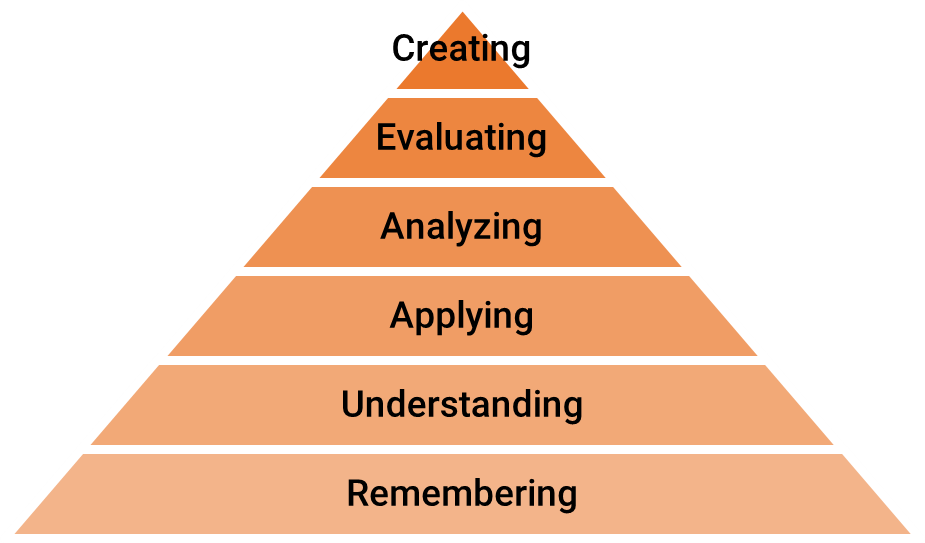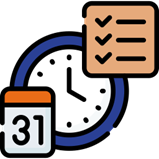Have you ever been a part of the “meeting after the meeting?” You know, the one where colleagues get together to debrief a meeting that’s recently taken place? The “meeting after the meeting” (MATM) typically includes two main agenda items: the debrief and the re-plan. First, attendees debrief to try to identify what actually took place or got achieved in the first meeting. Then they re-plan and schedule a new meeting, the purpose of which is to accomplish the progress or goals that should have been achieved in the first. Such a colossal waste of time, having multiple meetings when one should have sufficed!

Privy to more of these MATMs than I’d care to admit, I’d hypothesize that (if you’ve worked in Corporate America) you also have attended one or more of these meetings yourself. Why do they happen? When people let their busy schedules do the driving, it’s easy to end up just reacting to the calendar.
Who’s got time to THINK?!
In these “agile times”, when an entire release gets done in a week or two, there’s sometimes a perception that it’s not acceptable to wait 3 weeks?! to book a meeting. To get around that lead time, we start to plug “placeholder” meetings onto the calendar ahead of time, to make sure that people we’re going to need reserve their time for us; “we’ll update the agenda as we get closer.”
But how often do people go back and update the invite with that agenda? Not so much. With our calendars full of time slots blocked, we run from session to session with nary a thought about what we’re supposed to discuss or why. We are hard-pressed to prepare ahead of time, but everyone still attends! Certainly no one ever cancels or declines a meeting – there’s always something the group needs to talk about, after all. We’ll figure it out on the fly: “Why waste the time we have scheduled!”

Unfortunately, that time IS wasted. After the meeting falls flat — and it always will, given that situation — more time must be spent to regroup, re-plan, meet again. Without taking the time to think about upcoming collaborations or to plan for their effectiveness, we end up costing ourselves and our colleagues double- or triple-time. We continue to go round and round like hamsters on the wheel, stuck in our cycle of too-many-meetings but not-enough-time.
Schedule Time for Critical Thinking!
If you suffer from this kind of a crazy meeting schedule or a heavy project load, you’ve probably said to someone at some point, “I’m so busy, I just can’t think!” To regain our balance and fight the pressures of a busy schedule, we go on auto-pilot. Some set small goals and at least “get stuff done.” We run from meeting to meeting, we check task after task off the list, we try to feel accomplished. But accomplishment implies that a certain level of quality and achievement was realized as a result of all the “stuff” you got done. Is there an impact, then, when our schedules lack in time or ability to think?

If you’re a business analyst — absolutely! The most critical accomplishment for a business analyst is to “enable the organization to achieve its goals”. To achieve this, BAs must be able to provide capabilities or create conditions that the business does not currently have at its disposal. As a part of doing that, we work to “understand the structure, policies, and operations of an organization” and “recommend solutions” (BABOK® Guide). To get that kind of significant stuff done, you need time to “get your head around it.” Time to process, look at your information from all angles, interpret…there needs to be something more on your schedule besides meetings. You need to carve out time — significant time — to think!
Why? “Critical thinking is essential if we are to get to the root of our problems and develop reasonable solutions. After all, the quality of everything we do is determined by the quality of our thinking.”1
Why? Thinking takes time.
Why? It requires work.
Why? (As business analysts we’re trained to ask why a lot; bear with me!) Because … thinking is an active process.
So what?! (Another great BA question, btw.) Well, as anyone who has ever studied the BABOK® Guide should know, processes are performed to create outputs or outcomes. Hence, thinking should create outputs or outcomes. Okay, what outcomes might matter to you as a business analysis professional? What do you need from the thinking process? That is, why should you carve out “significant time” to think?
Why don’t we think about those questions for a minute?
We Learn Something By Thinking
Let’s tackle the outcomes of thinking. Thinking is a cognitive process; we process information, using our mind as the tool. What do we get out of that effort? We learn stuff! We think in order to produce learning from the information we have taken in and processed. In our role as BAs, we need to learn (it’s one reason why people who like to learn often make good business analysts! But I digress…).

What do we need to learn, then? Okay, we know that we need to learn about our business and our stakeholders…..what about them? Hmmm, “learning” doesn’t seem to be a very specific outcome.
Let’s be more specific. We need to learn about their problems, wants and needs. We need to learn about the options we have for solving their problems; we need to learn which of those options might be viable, practical or reasonable; we need to learn whether creating a specific solution will be beneficial, so that we can decide whether or not to move forward with it. There’s a bunch of “stuff” you need to learn as a result of your thinking.
However…that kind of learning is not the outcome you’d look for from sustained thinking. Smart, purposeful, critical thinking provides us with something more. Something beyond new or simple information acquired. Learning as an output or outcome of sustained thinking should create new information, knowledge, skills and abilities.
We Benefit When Thinking for Good Reason

If learning is an outcome from the process of thinking, and processes transform inputs into outputs, then…what inputs could we use for learning when some of the information we need to learn from isn’t “readily available” to us? How can we learn about options and ‘solution potential’, if we can’t easily elicit the information we need for our thinking “input”? Where does the input information come from?
It turns out that learning is achieved in levels or degrees. The extent to which you actively think about something, and the intellectual methods or standards you employ while engaged in thinking and learning, will drive for you different learning results. So yes, you need to take the time to think, but you also need to ensure you engage your mind appropriately, in order to perform the “work” that thinking requires. How much work, exactly? The amount of time and effort that you should allow for thinking completely depends on the reason(s) you have for thinking in the first place! Therefore, think about the outcomes you need to achieve because of your thinking efforts.
If learning is an outcome from the process of thinking, and processes transform inputs into outputs, then…what inputs could we use for learning when some of the information we need to learn from isn’t “readily available” to us? How can we learn about options and ‘solution potential’, if we can’t easily elicit the information we need for our thinking “input”? Where does the input information come from?
In the 1950’s, Dr. Benjamin Bloom, an educational psychologist and critical thinking advocate, devised a categorization system for educators, to support their development of learning objectives for students. Recently improved and revised, Bloom’s Taxonomy classifies different thinking processes or intellectual behaviors against types of information or knowledge (facts & processes) and aligns them to increasingly complex learning outcomes — the levels of learning achievement.

Reason for Good Thinking
Consider how those different levels of learning are reflected in our business analysis practices and end-products. For instance, when trying to show that you remembered what was elicited, you might create meeting minutes, or document interview notes. To demonstrate that you understood what you learned, problem statements, process models and ERDs are reasonable choices. If you had to take what you learned and apply it to your work, you might create UI designs, use cases or update existing flow charts. Which end-products effectively depict analyzed and evaluated information, or newly created information? Would the form or format of specific documents depict these? Or would those learning outcomes be reflected more in the quality of the content within those documents?
Analyzing, evaluating and creating are the higher-order thinking processes depicted in the taxonomy. They create new information and knowledge, and the practice of business analysis actually demands that we reach each one of those outcomes at some point in our analysis work. BAs have to do or produce something as a result of all our thinking and learning, otherwise we’re not doing our jobs!

Therefore, as with any other “problem to solve” via business analysis: consider what it is you’re trying to achieve. Are you trying to analyze the business process that stakeholders perform? Are you trying to evaluate the cost effectiveness of a specific approach or solution option? Are you trying to create new requirements so that your stakeholders can achieve a goal? Each of these objectives, according to Bloom’s Taxonomy, requires different modes and methods of thought.
Thinking is a Requirement for Quality Business Analysis
While elicitation may get us the information we need, we must take it further, because we can’t get it all from external sources. Of course, following our elicitation process is our analysis process. But what is analysis, really? Analysis is not to be confused with the process of documenting, diagramming or modeling all the information you’ve elicited, even though those things are typical end-products of our analysis process. If all you’re doing after elicitation is documenting the information you collected, without actually thinking about what it is that you have collected, what that information means, why it’s relevant, or a whole host of good critical thinking questions, then you have not achieved a quality analysis outcome.
Critical thinking is essential if we are to get to the root of our problems and develop reasonable solutions. After all, the quality of everything we do is determined by the quality of our thinking. — The Foundation for Critical Thinking
After doing our thinking, we either must decide we have learned enough to move into action, or we must translate our learning into new information and additional input — and then do it again! Thinking effectively isn’t a “once-and-done” event. You need to cycle back around, think again, think differently, think using different constructs, perspectives and considerations. We have to keep on thinking, repeatedly, until we finally learn what is needed to develop the best solutions for our stakeholders. We have to think creatively, but in this role — if you do nothing else — you must think critically. Otherwise, what value can you add as a BA?
Making the Case for Making the Time
It’s for these reasons that you need to carve out time — significant time — to think. Making time to think is not enough. In fact, spending time thinking is not enough. You have to “get your head into it,” engage your brain and really focus on what you’re thinking about. Also consider what you need to achieve from your thinking process. Don’t make the mistake of assuming that because you are engaged in the work you’re doing, that you are performing critical thinking. It is easy to be engaged in something without actually thinking, never mind critically, about what you’re doing.

Therefore, you must set aside the time you need to work through those techniques and processes effectively. Otherwise… you ultimately won’t achieve your goals.
Block off 1/2 day segments, call them “Thinking Thursdays” or “Mindful Mondays”, something smart and catchy. Create the expectation with your colleagues that business analysis needs time for analysis! Be sure to support yourself by acknowledging the fact that you need “time to think” in order to produce smart, quality deliverables, — then actually spend that time.
– Kate
Happy Meeting Plan Template Download
Need help avoiding the MATM (Meeting After The Meeting)? Try this!
Editor’s Note: This blog post was has been previously published by B2T on our previous website. Due to its popularity, Kathy has updated its content to be more comprehensive and accurate for the state of today’s environment.

Kate McGoey
AUTHOR
Kate McGoey is the former Product Development Director for B2T Training. Co-author of the original version of Business Analysis for DummiesTM, Kate has more than 30 years of experience in the IT industry. When not leading initiatives to help her company achieve strategic and tactical objectives, she seeks out opportunities to inspire others and give them “ah-hah!” learning moments. Kate is a talented change leader with a gift for untangling really challenging problems, translating business needs to technology, and connecting those dots that others might miss.




